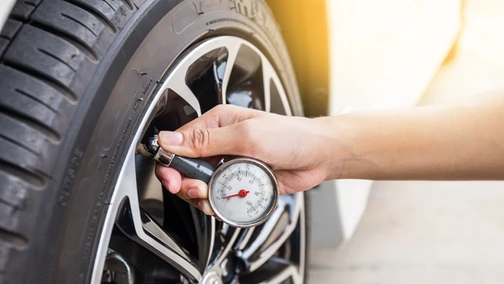Ignoring low tire pressure causes issues with handling, fuel economy, tire wear, and safety on the freeway! If it’s been awhile since you’ve last checked, or if temperatures have dropped, fill those tires – now!

Why You Shouldn’t Rely On Your Low Tire Pressure Warning Light (TPMS)
Similar to your low-fuel warning light, your tire pressure monitoring system (TPMS) warning light only comes on when your tire pressure is too low. Generally, the light comes on when your tire’s air pressure is 25% below recommendation. A drop of this level is quite severe. This means you will not be alerted of mild/moderate under-inflation of your tires.
Dropping Temperatures Causes Low Tire Pressure
The National Highway Traffic Safety Administration states that for every 10 degrees of reduced temperature, your tire pressure drops approximately 1 pound. Temperature changes can lead to significant tire pressure loss; which is why it’s a best practice to check your tire pressure as the seasons change.
4 Reasons To Avoid Low Tire Pressure
Low tire pressure, mild to severe, has measurable effects on your car’s handling, mileage, and safety.

1. Low Tire Pressure Affects Vehicle Performance
When tires are under-inflated, the sidewalls flex more than they were designed to when cornering and braking. Your tires become less stable and lose their grip and traction. You will notice steering becomes sloppy and braking is much slower – which could be horrible during an emergency situation when you’re trying to avoid an accident.

2. Low Tire Pressure Affects Gas Mileage
Have you ever ridden a bike with under-inflated tires? If so, you know how much harder you need to work to get moving. The same mechanism applies to your vehicle. Low tire pressure forces your vehicle to work harder due to the increased resistance that your under-inflated tires face when moving and gas mileage gets affected

3. Low Tire Pressure Reduces the Life of Your Tires
Low tire pressure causes abnormal and uneven distortion in your tire tread. In most cases, tire wear issues caused by low tire pressure can be seen on the tire’s inner and outer shoulders. It’s unfortunate because tire services are not cheap; whereas inflating your tires can be done virtually free and in minutes!

4. Driving With Low Tire Pressure Can Be Dangerous
The most dangerous issue caused by driving with low tire pressure is a tire blowout. As mentioned, under-inflated tire sidewalls flex more than usual and cause heat to build up. When on the freeway where you aren’t stopping frequently, where tires aren’t cooling off, they can overheat and blow. Aside from a blowout, an under-inflated tire has a higher probability of being punctured as they are softer.
What To Do If You Suspect Low Tire Pressure Or Your Tire Pressure Warning Light Comes On?

Understand Your Tire Pressure Recommendations
You can find your automaker’s tire pressure recommendations on your vehicle’s driver’s-side doorjamb or in the owner’s manual.
Check The Air Pressure In Your Car’s Tires.
You can purchase a handheld tire-pressure gauge for under $10.00 at any auto-parts store OR you can bring it in to any Integrity 1st Automotive location and we will take care of measuring and filling your tires for FREE.
Fill up your tires at the right time!
Your tires need to be cooler for an accurate reading. We recommend taking tire pressure measurements in the early morning or 2-3 hours before or after driving.



